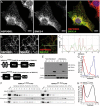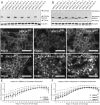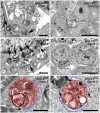SNX14 mutations affect endoplasmic reticulum-associated neutral lipid metabolism in autosomal recessive spinocerebellar ataxia 20
- PMID: 29635513
- PMCID: PMC5961352
- DOI: 10.1093/hmg/ddy101
SNX14 mutations affect endoplasmic reticulum-associated neutral lipid metabolism in autosomal recessive spinocerebellar ataxia 20
Abstract
Mutations in SNX14 cause the autosomal recessive cerebellar ataxia 20 (SCAR20). Mutations generally result in loss of protein although several coding region deletions have also been reported. Patient-derived fibroblasts show disrupted autophagy, but the precise function of SNX14 is unknown. The yeast homolog, Mdm1, functions in endoplasmic reticulum (ER)-lysosome/vacuole inter-organelle tethering, but functional conservation in mammals is still required. Here, we show that loss of SNX14 alters but does not block autophagic flux. In addition, we find that SNX14 is an ER-associated protein that functions in neutral lipid homeostasis and inter-organelle crosstalk. SNX14 requires its N-terminal transmembrane helices for ER localization, while the Phox homology (PX) domain is dispensable for subcellular localization. Both SNX14-mutant fibroblasts and SNX14KO HEK293 cells accumulate aberrant cytoplasmic vacuoles, suggesting defects in endolysosomal homeostasis. However, ER-late endosome/lysosome contact sites are maintained in SNX14KO cells, indicating that it is not a prerequisite for ER-endolysosomal tethering. Further investigation of SNX14- deficiency indicates general defects in neutral lipid metabolism. SNX14KO cells display distinct perinuclear accumulation of filipin in LAMP1-positive lysosomal structures indicating cholesterol accumulation. Consistent with this, SNX14KO cells display a slight but detectable decrease in cholesterol ester levels, which is exacerbated with U18666A. Finally, SNX14 associates with ER-derived lipid droplets (LD) following oleate treatment, indicating a role in ER-LD crosstalk. We therefore identify an important role for SNX14 in neutral lipid homeostasis between the ER, lysosomes and LDs that may provide an early intervention target to alleviate the clinical symptoms of SCAR20.
Figures






Similar articles
-
Cerebellar ataxia disease-associated Snx14 promotes lipid droplet growth at ER-droplet contacts.J Cell Biol. 2019 Apr 1;218(4):1335-1351. doi: 10.1083/jcb.201808133. Epub 2019 Feb 14. J Cell Biol. 2019. PMID: 30765438 Free PMC article.
-
Diverse species-specific phenotypic consequences of loss of function sorting nexin 14 mutations.Sci Rep. 2020 Aug 13;10(1):13763. doi: 10.1038/s41598-020-70797-2. Sci Rep. 2020. PMID: 32792680 Free PMC article.
-
Getting a handle on lipid droplets: Insights into ER-lipid droplet tethering.J Cell Biol. 2019 Apr 1;218(4):1089-1091. doi: 10.1083/jcb.201902160. Epub 2019 Mar 18. J Cell Biol. 2019. PMID: 30886057 Free PMC article.
-
Come a little bit closer! Lipid droplet-ER contact sites are getting crowded.Biochim Biophys Acta Mol Cell Res. 2020 Feb;1867(2):118603. doi: 10.1016/j.bbamcr.2019.118603. Epub 2019 Nov 13. Biochim Biophys Acta Mol Cell Res. 2020. PMID: 31733263 Review.
-
And three's a party: lysosomes, lipid droplets, and the ER in lipid trafficking and cell homeostasis.Curr Opin Cell Biol. 2019 Aug;59:40-49. doi: 10.1016/j.ceb.2019.02.011. Epub 2019 Apr 16. Curr Opin Cell Biol. 2019. PMID: 31003052 Review.
Cited by
-
Exome Sequencing Identifies a Novel Sorting Nexin 14 Gene Mutation Causing Cerebellar Atrophy and Intellectual Disability.Case Rep Genet. 2018 Oct 24;2018:6737938. doi: 10.1155/2018/6737938. eCollection 2018. Case Rep Genet. 2018. PMID: 30473892 Free PMC article.
-
The different autophagy degradation pathways and neurodegeneration.Neuron. 2022 Mar 16;110(6):935-966. doi: 10.1016/j.neuron.2022.01.017. Epub 2022 Feb 7. Neuron. 2022. PMID: 35134347 Free PMC article. Review.
-
SNX-PXA-RGS-PXC Subfamily of SNXs in the Regulation of Receptor-Mediated Signaling and Membrane Trafficking.Int J Mol Sci. 2021 Feb 26;22(5):2319. doi: 10.3390/ijms22052319. Int J Mol Sci. 2021. PMID: 33652569 Free PMC article. Review.
-
Mdm1 maintains endoplasmic reticulum homeostasis by spatially regulating lipid droplet biogenesis.J Cell Biol. 2019 Apr 1;218(4):1319-1334. doi: 10.1083/jcb.201808119. Epub 2019 Feb 26. J Cell Biol. 2019. PMID: 30808705 Free PMC article.
-
Inhibiting SNX14 Alleviates Epileptic Seizures by Regulating GluA2 Degradation via the Lysosomal Pathway.Mol Neurobiol. 2025 Aug;62(8):10902-10914. doi: 10.1007/s12035-025-04945-y. Epub 2025 Apr 16. Mol Neurobiol. 2025. PMID: 40237949
References
-
- Thomas A.C., Williams H., Seto-Salvia N., Bacchelli C., Jenkins D., O'Sullivan M., Mengrelis K., Ishida M., Ocaka L., Chanudet E.. et al. (2014) Mutations in SNX14 cause a distinctive autosomal-recessive cerebellar ataxia and intellectual disability syndrome. Am. J. Hum. Genet., 95, 611–621. - PMC - PubMed
-
- Jazayeri R., Hu H., Fattahi Z., Musante L., Abedini S.S., Hosseini M., Wienker T.F., Ropers H.H., Najmabadi H., Kahrizi K. (2015) Exome sequencing and linkage analysis identified novel candidate genes in recessive intellectual disability associated with ataxia. Arch. Iranian Med., 18, 670–682. - PubMed
-
- Karaca E., Harel T., Pehlivan D., Jhangiani S.N., Gambin T., Coban Akdemir Z., Gonzaga-Jauregui C., Erdin S., Bayram Y., Campbell I.M.. et al. (2015) Genes that affect brain structure and function identified by rare variant analyses of Mendelian neurologic disease. Neuron, 88, 499–513. - PMC - PubMed
Publication types
MeSH terms
Substances
Supplementary concepts
Grants and funding
LinkOut - more resources
Full Text Sources
Other Literature Sources
Molecular Biology Databases
Research Materials
Miscellaneous

